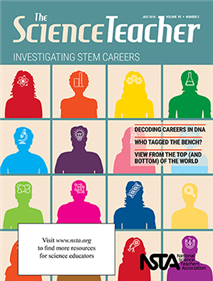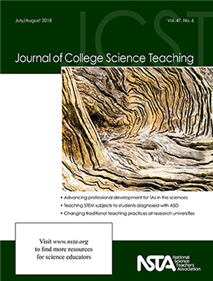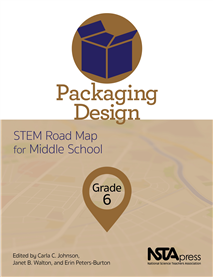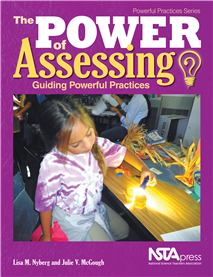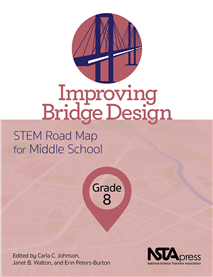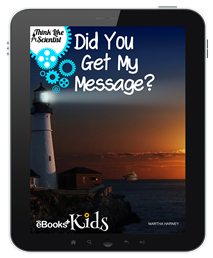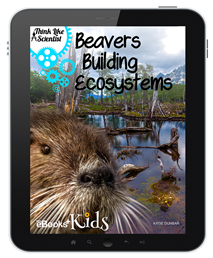All Resources
Journal Article
Editor’s Corner: A Good Day’s Work
The Science Teacher’s editor shares thoughts on the current issue....
Journal Article
Focus on Physics: Bow Waves to Sonic Booms
This column helps teachers build an understanding of physical principles. This issue discusses the effects when the source of water waves or the source of sound waves in air travels faster than the waves produced....
Journal Article
This column shares web tools that support learning. This issue describes how when using Google Maps, students can find patterns and trends that exist within a data set relative to their location, which can now be visualized in a few quick steps. Stud...
Journal Article
Career of the Month: Audio Engineer
This column shares interviews with professionals using science in the workplace. This issue describes Ivan Ortiz's career path to becoming an audio engineer....
Journal Article
Right to the Source: Encouraging Exploration—The WPA Poster Project
Exploring science and history with the Library of Congress. This issue discusses the The WPA Poster Project....
Journal Article
How Will We Freeze the Ice Cream?
Combine engineering and chemistry to learn how to create your own ice cream....
Journal Article
Explore the physical mixing of substances with water to create a solution or suspension. ...
Journal Article
Where Does a Tree Get Its Mass?
Measure trees to estimate their mass as part of an exploration of photosynthesis and plant growth....
Journal Article
Classic Lessons 2.0: The Discovery Demonstration
This column shares updated perennial classroom favorites. This issue discusses a variation on the traditional classroom demonstration— the discovery demonstration—which is structured so that students are actively involved in making sense of the d...
Journal Article
Integrating Technology: Depth of Knowledge and Conceptual Understanding
This column shares how teachers use technology for assessment, student learning, or classroom management. This article shows how an engaging, interactive online density simulation allowed students to predict, manipulate, and analyze data effectively ...
Journal Article
Practical Research: Help! I’ve Been Asked to Coach a Robotics Team
This article offers recommended mentoring strategies for teachers new to coaching robotics teams....
Journal Article
From the Editor’s Desk: The Meaningful World of Matter
Science Scope’s editor shares thoughts regarding the current issue....
Journal Article
Disequilibrium: Oobleck: Is It a Solid or Liquid?
This column shows how to use discrepant events to confront misconceptions. This article discusses two engagement activities using oobleck....
Journal Article
Listserv Roundup: A Short Guide to Genius Hour Makerspaces
This column shares recent conversations taken from the NSTA listserv community about current science education topics. This month’s column is a compilation of resources and advice shared via NSTA’s e-mail listservs by teachers who successfully u...
Journal Article
Science for All: Ready, Fire, Aim!
This column shares strategies for increasing student engagement. This article discusses strategies to handle impulsivity in the science classroom....
Journal Article
Teacher to Teacher: Supporting Students With the Four Question Strategy
This column provides practical advice from your peers. In this article students use the Four Question Strategy to design, construct, and test the performance of hand warmers....
Journal Article
Citizen Science: Citizen Science at the Shore
This column highlights formal and informal science research projects that students can join and contribute to by gathering and sharing data. This article describes the Great Eggcase Hunt....
Journal Article
Scope on the Skies: Return to Sender (part 1)
This column focuses on astronomy throughout the year. This issue discusses the Parker Solar Probe, Mars, and July celestial events....
Journal Article
Strategies for Teaching STEM Subjects to College Students With Autism Spectrum Disorder
The purpose of this qualitative study is to collect the experiential knowledge of 12 science, technology, engineering, and mathematics (STEM) faculty about teaching students who have autism spectrum disorder (ASD)....
Journal Article
A small undergraduate liberal arts college explored a model, grounded in the literature, to develop a shared vision for its science and math general education curriculum that focuses on scientific literacy skills. This process has allowed the author...
Journal Article
The authors investigated 16 professional societies’ educational expectations related to structure and function, revealing the presence of multiple discipline-specific disambiguations....
Book Chapter
This lesson introduces the module and the Product Design Challenge. It engages students with packaging by asking them to respond to a display of products and consider the appeal of the packaging to buyers. It also provides students with the opportuni...
Book Chapter
In this lesson, students continue to prepare for their Product Design Challenge by building background knowledge required to complete the project. This includes exploring three dimensional shapes, calculating surface area and volume, and learning abo...
Book Chapter
Marketing Your Product in a Global Economy
In this lesson, students learn about the marketing profession and world economy. They continue to explore how marketing influences consumers. Students work in groups to design and present a marketing plan for the team’s product, which includes logo...
Book Chapter
Why Is Assessing a Powerful Teaching Tool?
Authentic assessments shine a light on learning for both students and teachers! Assessments allow students and teachers to reflect on and celebrate successes along the learning journey while engaging in questioning, investigating, and assessing as a ...
Book Chapter
How Do I Design Authentic Assessments to Meet the Needs of ALL Learners?
Students need opportunities to show what they know in a variety of ways and at multiple points along the way. Knowing what to look for and how to interpret what you see may guide you to plan new experiences. Questioning, investigating, and assessing ...
Book Chapter
How Does Metacognition Support Instructional Decision Making?
Metacognition engages students and teachers in reflection of the learning process—in essence, thinking about thinking. Metacognitive questions give teachers a better understanding of how students are processing content, the types of connections the...
Virtual Conference
Archive: Using Phenomena to Drive Student Learning, July 28, 2018
Science is ultimately about explaining the phenomena that occur in the world around us. Recent reforms in science education have focused on how phenomena should be used during instruction. This conference will focus on how using phenomena effectively...
Book Chapter
Improving Bridge Design, Grade 8: STEM Road Map for Middle School (Book Sample)
What if you could challenge your eighth graders to strengthen the nation’s infrastructure by designing bridges that last longer? With this volume in the STEM Road Map Curriculum Series, you can! Improving Bridge Design outlines a journey that wi...
Journal Article
Science Investigation and Developing Students’ Science-Process Skills Through Citizen Science
It’s 7:15 on a Friday morning and the ‘early birds’ have arrived. Eager students don their binoculars for Ms. Vigeland’s before-school birdwatching club. Ranging from fourth to eighth grade, these Hilltop Country Day School students...
By Jennifer Fee
Journal Article
The Philly Scientists project engages underserved youth in grades 5–8 and their educators in a curriculum that includes a mobile application with a digital badging reward system. ...
By Rasheda Likely, Magdalene Moy, and Nancy Songer
Journal Article
The Curiosity Machine Family Program at Iridescent Learning brings underserved families together over five weeks to do open-ended engineering design challenges with the help of scientists and engineers, who mentor the families as they build. &nb...
By Wallace Louie, Tara Chklovski, Maggie Jaris, and Audra Torres
Book Chapter
The Power of Assessing: Guiding Powerful Practices (Book sample chapter)
The Power of Assessing will show you how to use authentic assessments as a dynamic teaching tool. But this book doesn’t just describe ways to evaluate your students’ learning. Through colorful photographs and over 30 minutes of video footage you ...
eBook
The Power of Assessing: Guiding Powerful Practices (e-book)
The Power of Assessing will show you how to use authentic assessments as a dynamic teaching tool. But this book doesn’t just describe ways to evaluate your students’ learning. Through colorful photographs and over 30 minutes of video footage you ...
Book Chapter
Packaging Design, Grade 6: STEM Road Map for Middle School (Book Sample)
Packaging Design outlines a journey that will steer your students toward authentic problem solving while grounding them in integrated STEM disciplines. As are the other volumes in the series, this book is designed to meet the growing need to infuse r...
Interactive E-book Kids
There are many methods for communicating. Some methods are easy to understand, while other methods require learning or decoding. As students explore communication systems, they will discover that each has benefits and drawbacks. This book focuses ...
Interactive E-book Kids
Studies have shown that wetlands created by beaver dams are more biodiverse than human-made wetlands. Beavers’ first impact on the environment begins with dam building. Using their powerful teeth and engineering instincts, they significantly alte...
Journal Article
Connecting Fossil Clubs With K–12 Teachers
FOSSILs4Teachers! is a professional development workshop that allows K–12 educators and museum paleontologists to collaborate on fossil resources and standards-aligned lesson plans about fossils. ...
By Jeanette Pirlo, Bruce J. MacFadden, Eleanor E. Gardner, Victor J. Perez, and Denise Porcello



